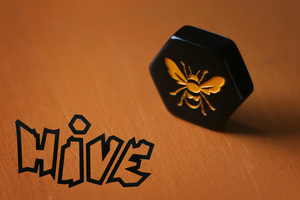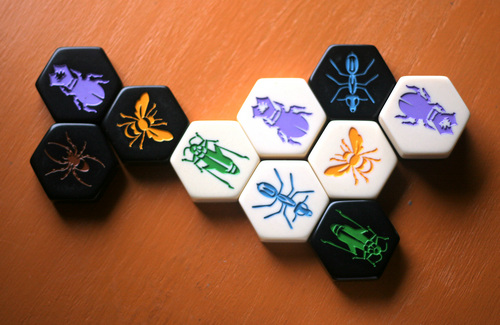Break out in Hive: A chess-like logic game

Mike Hulsebus | Contributor
Hive is an abstract strategy game that I picked up based on glowing reviews that called it things like “a major achievement in gaming” and also because I was buying TurboTax on Amazon and needed something to bump myself into the free shipping range.
Saying Hive is an abstract strategy game is a way of saying that it has no theme, similar to games like chess, backgammon or Go. In Hive, two players alternate placing and moving their color bugs around the hive. You win by surrounding the opposing queen bee on all sides. Hive is definitely not the game for me, but let’s see if it may be the game for you.
I had high hopes for Hive. It has great pieces, is really portable, is pretty easy to learn, and is a decently short game if you and your opponent aren’t going to sit and stare at the board for 10 minutes before taking each turn.
Each bug moves in its own special way. The bee, for example, moves like a king in chess and can move one space in any direction. When I say “space” I use the term loosely since there isn't a set board: pieces can be placed anywhere on the table so long as they touch only pieces of your color. They can then move from there on later turns.

Mike Hulsebus | Contributor
The Grasshopper moves by jumping over any number of pieces so long as it moves in a straight line. The Beetle is able move a space and climb on top of pieces, rendering the ones underneath it immobile. Ants move along the perimeter of the mass. Spiders move exactly three spaces. That’s it. There are additional rules on top of this, but those are the basics.
It sounds simple, but there’s a huge amount of strategy in how all of those pieces interact. I couldn't sit you down to chess, saying, "the bishops move diagonally, the pawns move one space, the knights jump in an L shape, and here's how the other pieces move," and expect you to have a good feel for what chess is like. Similarly, I can't expect that simple explanation shows up the strategy in how games play out.
One of the key elements of the strategy is that all of the pieces always have to be one continuous collection of pieces; the Hive can never be divided. So if your opponent plays a Beetle that you don’t want to immobilize your Bee, you can try to move pieces so your opponent can’t move the Beetle by putting the Beetle in such a position that moving it would separate the Hive. The fact that the previous sentence was hard to follow is a both a detriment to my ability to explain this game and a prime example of how, to win, you have to be able to look multiple moves ahead to strategize.
The game shares a lot with chess: both in the sort of play it offers and in the fact that I never really feel like playing the game. That’s just me. I’m not the kind of person who likes studying a Scrabble board before making a move: I’m just going to play a pretty good word once I find one to keep the game moving.
Hive is too much of a brain burner for me, but I think that other people will like it for its strategy, replayability and strategy. If you like chess, I do really think that you’ll find this game fun.
If the game seems like it might appeal to you, try it out. Along with the rules, the publishers of Hive have posted an online version of the game that will handily defeat you every time. Or maybe just me.
Mike Hulsebus once made up his own book of secret chess moves out of printed websites and construction paper for an in-class elementary school tournament. It didn’t help. He can be reached at mikehulsebus@gmail.com.


Comments
Erica Lanni
Wed, Jun 16, 2010 : 6:51 p.m.
I love this game! My friend and I play all the time, it's quick and we like the strategy. There is also a HIVE iphone app that is fun.